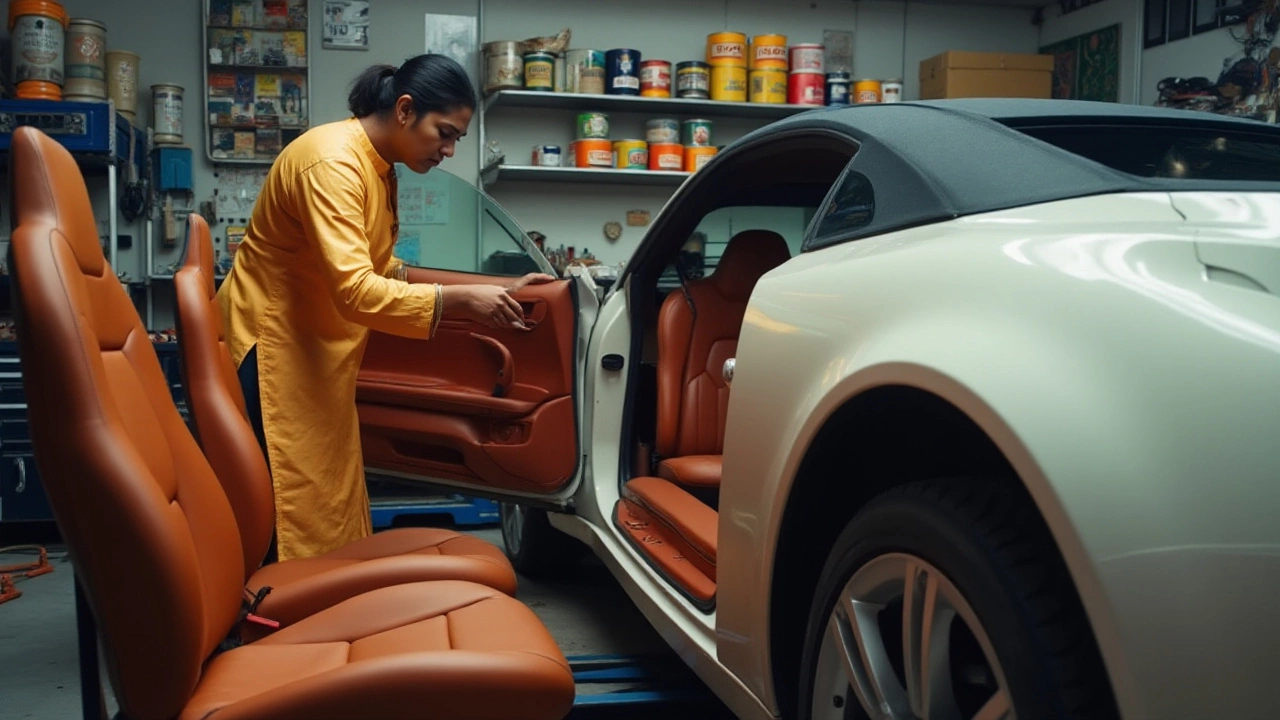DIY Guide: Installing Katzkin Leather Seats in Your Car
 Jan, 5 2025
Jan, 5 2025
Transforming your vehicle's interior can be a fulfilling project, giving your car a fresh, stylish look that you can proudly call your own work. When considering a DIY installation of Katzkin leather seats, it's essential to evaluate the process fully, from preparation to execution.
Journey with us through this article as we delve into the requirements for a successful installation, providing practical advice and potential pitfalls to watch out for. Whether you're a seasoned DIY enthusiast or just beginning to explore automotive projects, this guide aims to shed light on the intricacies involved in upgrading your car's seating with Katzkin.
- Understanding Katzkin Leather
- Tools You'll Need
- Preparing Your Vehicle
- Installation Process
- Potential Challenges and Solutions
- Final Touches and Maintenance
Understanding Katzkin Leather
Katzkin leather is renowned in the automotive industry for its luxurious feel and exceptional durability, crafting a reputation synonymous with high-quality car interior customization. Established in 1983, Katzkin has become a leader in the market, providing leather seat covers that not only enhance the aesthetic appeal of vehicles but also offer resilience against the daily wear and tear that every car interior inevitably faces. What sets Katzkin apart from many other brands is its commitment to using top-grain leather, which ensures a soft, pliable texture while maintaining strong resistance to damage.
The customization options available with Katzkin leather seats are extensive, catering to a variety of tastes and preferences. Vehicle owners can choose from a wide array of patterns, colors, and stitching designs, allowing for unique personalization that matches each individual’s style. This versatility is complemented by the brand's focus on precision fit, which means that each seat cover is tailored to the specific dimensions of the car model, ensuring a seamless look once installed. DIY car seats enthusiasts appreciate this aspect, as it helps minimize potential errors during installation.
“Katzkin is not just about upgrading the look of your vehicle; it’s about transforming your entire driving experience,” said James Scott, a well-respected automotive expert. “The attention to detail in their products reflects their passion for quality.”Additionally, it's worth noting that Katzkin doesn't just offer aesthetic benefits. Many vehicle owners have reported that switching to leather seats helps with temperature regulation during extreme weather conditions, keeping the car cooler in the summer and warmer in the winter. This is primarily due to leather's natural ability to dissipate heat more efficiently than synthetic materials, an attractive feature for those looking to improve comfort in their rides.
Lastly, Katzkin’s commitment to sustainability is noteworthy. They've made significant strides in sourcing their materials responsibly, aiming to reduce the environmental impact of their production processes. Most of their leather is tanned using eco-friendly practices, which include water-based solvents and recyclable packaging. As sustainability becomes an increasingly important factor for consumers, Katzkin’s efforts in this area resonate well with ecologically conscious buyers.
Tools You'll Need
Diving into the installation of Katzkin leather seats requires not just enthusiasm but a careful selection of tools to ensure precision and effectiveness. Having the right equipment on hand can make the difference between a frustrating ordeal and a smooth, rewarding experience. When you're setting out on this DIY endeavor, a well-rounded toolkit is your best friend. At the core of your tool assembly should be a basic set, including both a standard and a Phillips head screwdriver to tackle the variety of screws you might encounter during seat removal and reassembly. These interchangeable tools will come handy across numerous tasks, making them indispensable for an array of interior customization projects.
If you're aiming for professional-level installation, a good-quality staple gun and hog ring pliers will prove essential. The staple gun will assist in attaching seat upholstery to the frames securely, while the hog ring pliers are crucial for affixing the leather covers snugly to the seat frame. These items offer robust support that holds up well under everyday use. Beyond this, a socket wrench set can greatly simplify the process of bolting and unbolting the car seats. Given the variations in car models, having a set allows you to adapt to different bolt sizes effortlessly.
It's also wise to consider investing in a heat gun, as this can help stretch the leather across tricky corners and curves, ensuring a tight, wrinkle-free finish. Always prioritize a safe and measured approach when using powered tools to avoid any mishaps or unnecessary wear on your car’s interior components. Some enthusiasts prefer using plastic trim removal tools to prevent scratching or damaging delicate surfaces around your seats. These are particularly useful when prying plastic parts away without leaving unsightly marks. DIY car seats enthusiasts often share the compelling advice: "A task well begun is a task half done."
Don't forget the protective measures—take coveralls or heavy-duty clothing into account, closing the gap on any potential damage from sharp edges or stubborn staples. Efficiently managing these protective steps can make your work process less hazardous and more enjoyable. Should miscalculations occur (and they often do), having zip ties can serve as a hack when something needs to be temporarily held in place or adjusted. A handful of cloth rags or towels for wiping down work surfaces and keeping your new seating clean throughout installation is a low-tech but highly valuable addition to your setup.
“Precision is key when it comes to automotive upholstery. The right tools are not just about getting it done, but getting it done right,” advises John Sanderson, an industry expert in car interior restoration.
Ultimately, the toolbox you assemble will reflect both the complexity of your installation goals and your comfort level with handling such equipment. So, take some time to consider your niche needs within the vibrant cosmos of custom car upholstery. Remember, preparation is more than half the battle won and lays a solid foundation for an impressive transformation of your vehicle's interior.

Preparing Your Vehicle
Before diving into the actual installation of the Katzkin leather seats, your first task is to ensure your vehicle is properly prepared. This step is crucial to avoid any mishaps during the process, and to guarantee that your end result is not only visually impressive but securely installed. Begin by giving your car's interior a thorough clean; dirt, dust, and debris can interfere with both removal and installation and might lead to less than perfect results. Vacuum the seats thoroughly and clean the surrounding areas where new upholstery will fit, ensuring your new investment has a pristine starting point.
Once cleaning is done, the next step is to prepare the seat frames for the custom car upholstery. Removing the existing upholstery may seem daunting, but it’s a challenge worth undertaking. Carefully inspect your current seats to understand how they are held together; screws, clips, and bolts are commonly used in many vehicles. You'll want to keep track of all the removed elements, perhaps by organizing them in labeled bags, as they will be vital when securing your new seats. It's worth noting the placement and connection points of any electrical components related to heated seats or sensors, if present, to reattach them properly.
During preparation, consider the advice of auto enthusiasts who have undertaken similar projects.
"A well-prepared car can make all the difference in installing something as intricate as seat upholstery," advises Roy Herford from Auto Online.He suggests taking detailed photographs of each step during disassembly, allowing you to reference them if you find yourself in doubt later in the process. Documenting your actions can save you from potential frustration down the line, especially when dealing with difficult-to-remember configurations.
Another significant aspect to consider is the seating hardware. Inspect thoroughly for any signs of wear and tear that might need attention. It’s also essential to verify that all seat adjustment mechanisms are working smoothly; any faults should be addressed before installing the new leather. If issues arise, you may need to replace or repair components at this stage. Quality installation often depends on these small but critical checks, ensuring that the foundations of your seating are solid and trustworthy.
Now, onto protective measures. Laying down protective mats or covering areas of your interior that may scratch during the process is a good idea. Protecting these surfaces ensures that your task does not result in unnecessary cosmetic damage, keeping your car’s interior as immaculate as your soon-to-be leather seats. Before moving forward, double-check that you have all the necessary tools on hand, including specialized tools if required, depending on your car model. Such tools may include screwdrivers, pliers, panel removal tools, and a heat gun, among others that might come in handy.
By preparing your vehicle meticulously, not only are you setting the stage for easier Katzkin installation, but you are also making sure that your new leather seats will sit perfectly, enhancing both the aesthetics and functionality of your car’s interior. Consider this preparation time as a form of investment into the longevity and appearance of your vehicle, an effort that pays off every time you settle into your lush, self-installed leather seats.
Installation Process
Diving into the world of Katzkin installation, the journey begins with understanding that this isn't just a job for experienced mechanics or custom car professionals. It's a task that can be taken on with the right guidance and attention to detail. Installing these custom leather seats requires careful adherence to each step in the process. Let's take a deeper dive into what it entails. Before you proceed, make sure your DIY spirit is revved up as the path can challenge but certainly reward your efforts tenfold.
The first step in tackling a DIY car seats project like this is to ensure your work environment is clean and organized. You'll need ample space to lay out tools and components, so working in a garage or a spacious driveway is ideal. Have your new Katzkin kit and tools ready, double-checking each item against your checklist. Start by carefully removing the existing upholstery, and though it might seem a mundane task, it’s integral to paving a smooth road ahead.
Begin by safely removing the car battery's negative terminal to avoid any accidental airbag deployments while working on the seats. Take out the seat bolts using appropriate tools, and gently detach the seatbacks and cushions. Having a buddy system can be beneficial here as the seats can be awkward to handle alone. As you pull the old covers from the cushions, take note of the anchor points and the order of removal, as you'll need to mirror this process in reverse. Snap a few reference photos along the way – they’ll serve as your roadmap during reinstallation.
Once your car’s interior is stripped, lay the new custom car upholstery on each piece, carefully unfolding them to smooth out any wrinkles or creases. The leather should be allowed to sit at room temperature, making the material more pliable as you dress each cushion. This process resembles putting on a snug glove – it’s a detailed task to slip and stretch the material into place, ensuring a tight fit.
"Precision and patience are your best tools," shares Randy Smith, an expert in the field of automotive interiors. "Rushing through just one step can compromise the entire look of your final result."
Next comes the reassembly, a stage requiring extra attention where you work backward from your dismantling notes and photos. Reattach the seats securely, ensuring each fixture is locked into place. Don’t forget to reconnect the battery, seeing your renewed seats spring to life in their vibrant glory should inspire a sense of achievement and satisfaction. Should any issues arise, stopping to troubleshoot rather than forcing anything is always wise. Common challenges include realigning seat tracks and ensuring even tension of the covers across the foam inserts.
Once all is set and done, consider taking a test drive. Not just to show off your handiwork but to feel out any necessary adjustments. Congratulations! You’ve just tackled the art of turning ambition into action, leaving a refined touch of luxury within your vehicular realm. You now rightly possess the knowledge to affirmatively answer, 'Can I install Katzkin myself?' with a resounding yes!

Potential Challenges and Solutions
Embarking on the journey of installing Katzkin leather seats in your vehicle by yourself is not without its hurdles. Those eager to refresh their car's look must prepare for some challenges that are often underestimated. For instance, while it might seem straightforward, removing the factory seats requires precision and a keen understanding of your car’s configuration. Certain car models present particular intricacies in accessing seat mounts, not to mention handling the various electrical components linked to seatbelts or heating elements. A simple lapse in attention or improper disconnection can lead to inconvenient, if not expensive, mishaps, requiring much more than just a manual fix or added hours to troubleshoot problems.
One significant challenge lies in the proper alignment and fitting of the new leather covering over the existing cushions. The leather needs to be snug without being overly tight to maintain a polished finish and to prevent premature wear. Remember, DIY car seats projects can become frustrating if the initial fit doesn't appear right. This challenge primarily arises from the variability in foam densities of seat cushions, which might create unforeseen creases or lack the smoothness one desires. To mitigate these effects, leveraging help from a friend might ease the process, ensuring even stretching. Alternatively, a heat source, such as a hairdryer, can be used judiciously on low settings to help mold and stretch the leather into place, giving it a natural, glove-like fit.
Another considerable consideration is the wiring for any electric components. When dealing with modern vehicles, they often come equipped with seat heating, cooling mechanisms, or advanced airbag systems. Mishandling these electrical components could not only damage the seats but also pose safety risks. It's imperative to have a comprehensive guide for your specific vehicle model and to ensure the electrics are correctly reconnected to avoid triggering warning systems. As advised in a recent article from Car Customization Magazine,
"Unfamiliarity with vehicle electrical systems can transform a cost-effective project into a costly ordeal. Proper research and understanding before diving into these tasks are crucial."
To further bolster success rates and circumvent unnecessary stress, physical workspace conditions mustn't be ignored. Ample space contributes significantly to comfort and efficiency during installation, minimizing the potential for error caused by cramped conditions or insufficient lighting. Additionally, when tension rises, and nothing seems to fit right, a calm approach can help. Break down each step, and don't rush. Laborious projects like this call for patience—the pièce de résistance of many a seasoned DIY enthusiast’s toolkit alongside their custom car upholstery guides.
While these challenges are quite typical, they are not insurmountable. Each can be addressed with preparation, a touch of creativity, and possibly a small investment in time and patience. Remember, the pleasure is often found as much in the process as it is in the end result, especially when you close the car door to admire the luxurious looking seats that you installed yourself.
Final Touches and Maintenance
Once you've successfully installed your new Katzkin leather seats, the last steps involve attention to detail. This is where you finesse the installation, ensuring that every inch of the seat upholstery snugly fits and the aesthetic is as expected. Proper alignment and tight fitting are key aspects to achieve that factory-finish look. Take a closer look at the edges and seams, making sure they align perfectly with the car’s design. Subtle adjustments can make a significant difference, so don’t skip this crucial step.
Next, move on to securing and tightening any fasteners or clips that were part of the installation process. This could mean double-checking bolts or screws that need a final turn or ensuring Velcro strips are properly aligned and adhered firmly. Bear in mind, the goal is to achieve a seamless look that complements your car’s interior rather than appear as a hasty addition. A useful tip is to shine a light across the installed seats, as shadows often reveal areas that might not be as tight as they should be.
To maintain the new car smell and the pristine condition of Katzkin installation, regular maintenance is key. Leather care begins with the right cleaning products; never use harsh chemicals as they can damage the leather. Instead, opt for pH-balanced, leather-specific cleaners. A routine bi-monthly cleaning can help maintain the longevity and appearance of your seats. Consider investing in quality conditioners that will nourish the leather, keeping it supple and resistant to cracking or fading.
Weather can also play a significant role in maintaining your seats. Protect your investment by parking in shaded areas or using a sunshade to prevent excessive heat exposure inside the car. According to a study, UV radiation can significantly affect leather upholstery, leading to discoloration and deterioration. Be mindful during colder months as well; extreme cold can make leather brittle, so maintaining a moderate internal temperature using well-regulated heating is advisable.
"Leather is a natural material that requires care and attention to maintain its luxurious feel and appearance. Regular maintenance not only preserves the aesthetic appeal but also extends the lifespan of your seats." - Auto Upholstery Expert from LeatherHQ.
For car enthusiasts keen on details, consider adding personal aesthetic touches. Custom embroidery or the addition of matching floor mats can accentuate the new custom car upholstery. These minor enhancements add personal flair and are a testament to your craftsmanship. Completion of installation with these final touches ensures that not only does the car feel like new, but it resonates with your personal style and attention to detail.